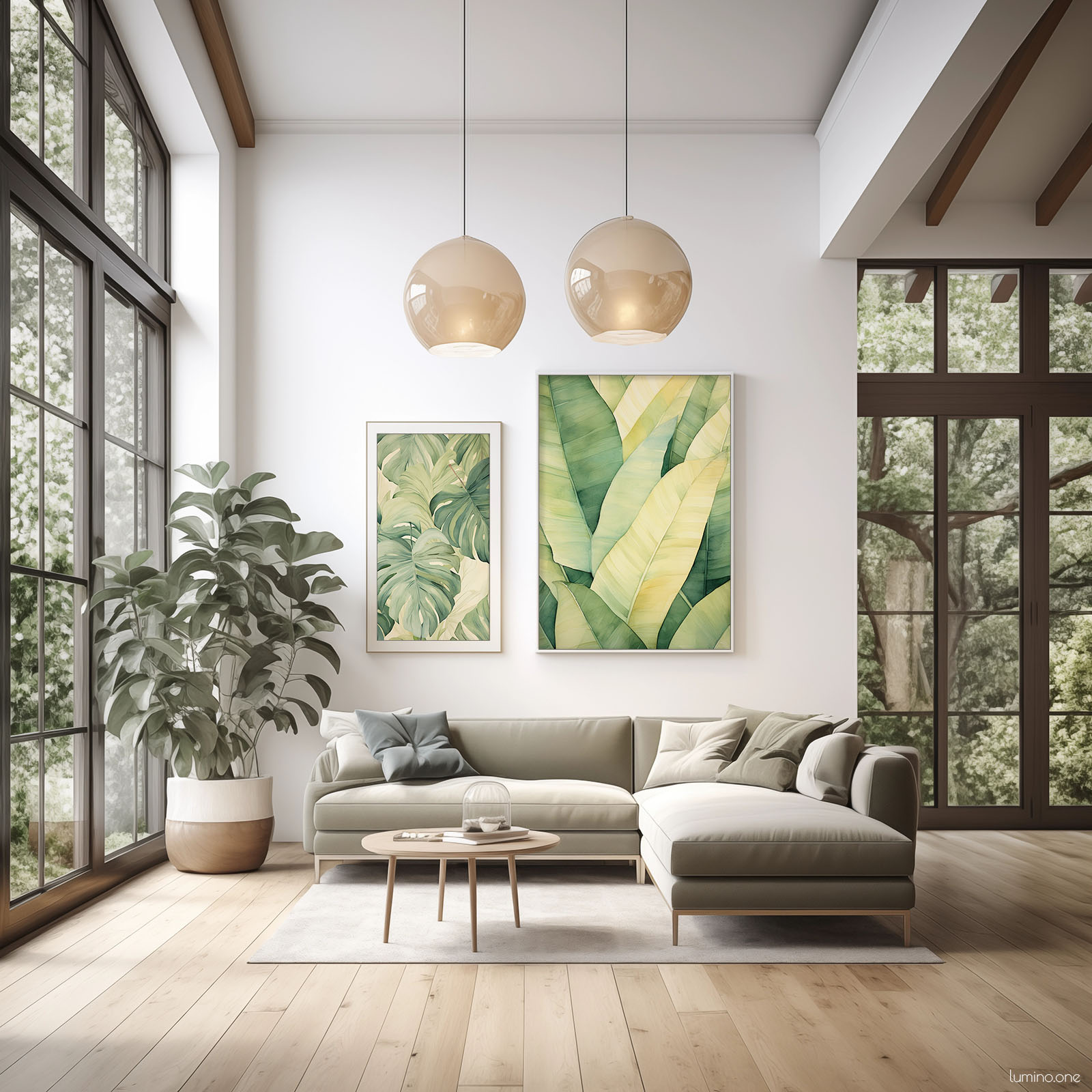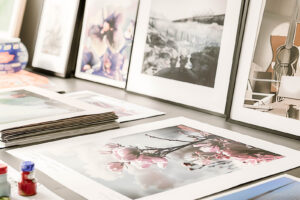The perfect wall art size is key to your room’s aesthetic. From common dimensions to custom specs, our guide will help you pinpoint the ideal choice for any wall. Grasp the essentials of standard sizes, aspect ratios, and navigating the space you have, ensuring your art prints not only fit, but elevate your surroundings.
Key Takeaways
- As an artist, providing a range of standard and custom art print sizes lets you meet the diverse preferences and budgets of your customers. As a homeowner or interior designer, this variety means finding the perfect print that fits your space’s specific needs, ultimately boosting your room’s visual allure.
- Selecting the ideal art print size for your space is key to achieving a harmonious balance with your room’s decor. Aim for a print that occupies 60-75% of the wall space and coordinates with the width of your furniture, especially for medium to large sizes.
- Choosing the perfect frame material and color is vital to enhance both the artwork and your room’s aesthetic. Moreover, experimenting with various display techniques can infuse depth and dynamism into your art print presentations, regardless of the space type.
Understanding Art Print Sizes
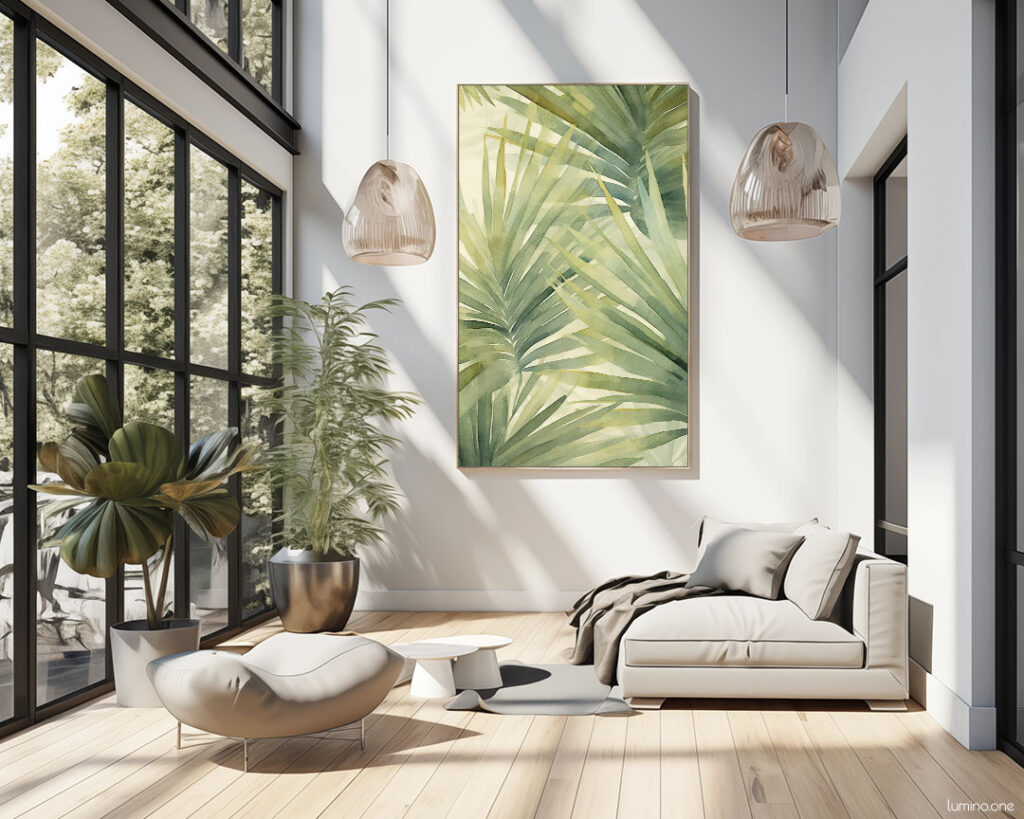
When it comes to elevating your interior with wall art, size really does matter. The dimensions you choose can transform the look and feel of a room, turning it into a reflection of your unique style.
Whether you’re a homeowner keen on sprucing up your living space or an interior designer crafting beautiful environments, understanding art dimensions is crucial.
Let’s dive into the world of common sizes, aspect ratios, and the possibility of custom options. This journey is about finding that perfect piece which not only fits your wall but also complements the room’s ambiance.
I’m here to help you navigate these choices, ensuring your home is enhanced beautifully with just the right artwork. Together, we’ll learn how different sizes can change the dynamics of your room, creating a visually stunning and harmonious environment.
Standard Art Print Sizes
When selecting art prints for your space, it’s fascinating to see how art measurement varies across the globe. From Europe to North America and Australia, each region has its standard sizes, reflecting their unique artistic and cultural dimensions. Understanding these standards can be incredibly helpful, whether you’re a homeowner looking to adorn your walls or an interior designer aiming to create a globally inspired space.
North America: Varied Dimensions. In North America, art print sizes are a quite varied and don’t adhere to any strict standard like the International A series. You’ll find a range of sizes that are widely used and recognized in the art and framing industry.
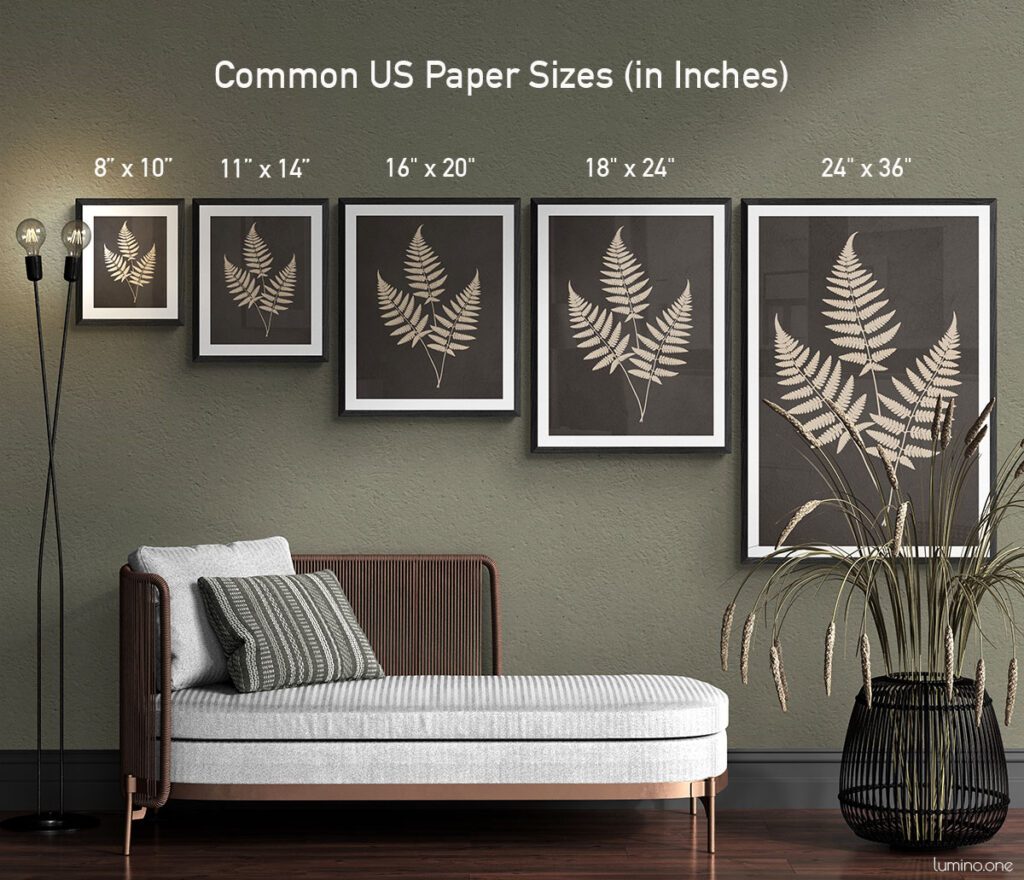
Common North American Art Print Sizes (Width x Height):
- 8″ x 10″
- 11″ x 14″
- 16″ x 20″
- 18″ x 24″
- 24″ x 36″
- 36″ x 48″
Europe: The A Series. In Europe, the standard for art prints follows the A series. This series is part of the international standard (ISO 216), which most countries globally adopt. The sizes decrease in a systematic way, where each size is half the size of the one before it when folded parallel to its shorter sides.
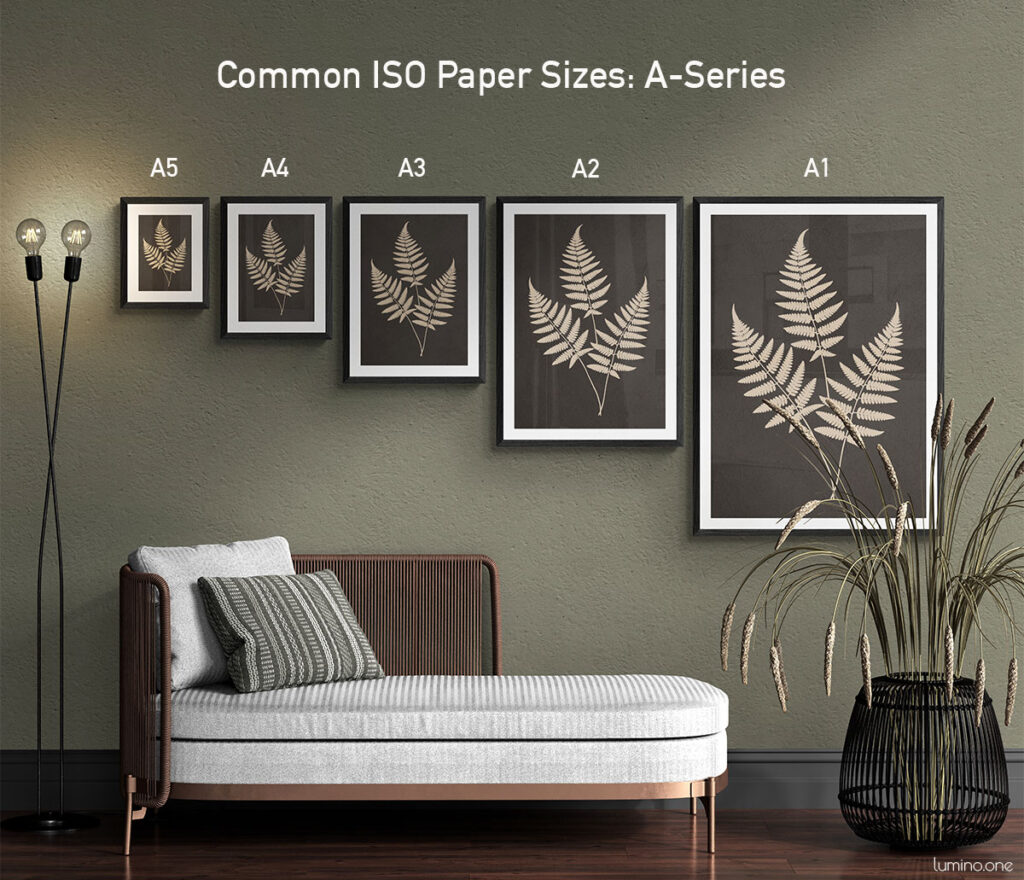
Common European Art Print Sizes (Width x Height):
| Paper Size A Series | Paper Size Width & Height in Millimeters | Paper Size Width & Height in Inches |
| A5 | 148mm x 210 mm | 5.8″ × 8.3″ |
| A4 | 210mm x 297mm | 8.3″ × 11.7″ |
| A3 | 297mm x 420mm | 11.7″ × 16.5″ |
| A2 | 420mm x 594mm | 16.5″ × 23.4″ |
| A1 | 594mm x 841mm | 23.4″ × 33.1″ |
| A0 | 841mm x 1189mm | 33.1″ x 46.8″ |
Australia: A Mix of Standards. Australia presents an interesting mix, using both the A series and the North American standard sizes. This blend offers a wide range of options for art enthusiasts and professionals alike.
Common Australian Art Print Sizes (Width x Height):
- A4: 210mm x 297mm
- A3: 297mm x 420mm
- A2: 420mm x 594mm
- 8″ x 10″
- 11″ x 14″
Understanding these standard sizes helps in choosing the right art print that not only fits your space but also aligns with global aesthetic standards. Whether you prefer the systematic European sizes or the varied North American dimensions, there’s a size out there that’s perfect for your needs. These sizes serve as a great starting point for visualizing and planning your space, ensuring that the art you choose enhances and complements your environment perfectly.
Aspect Ratios and Their Impact on Art Prints
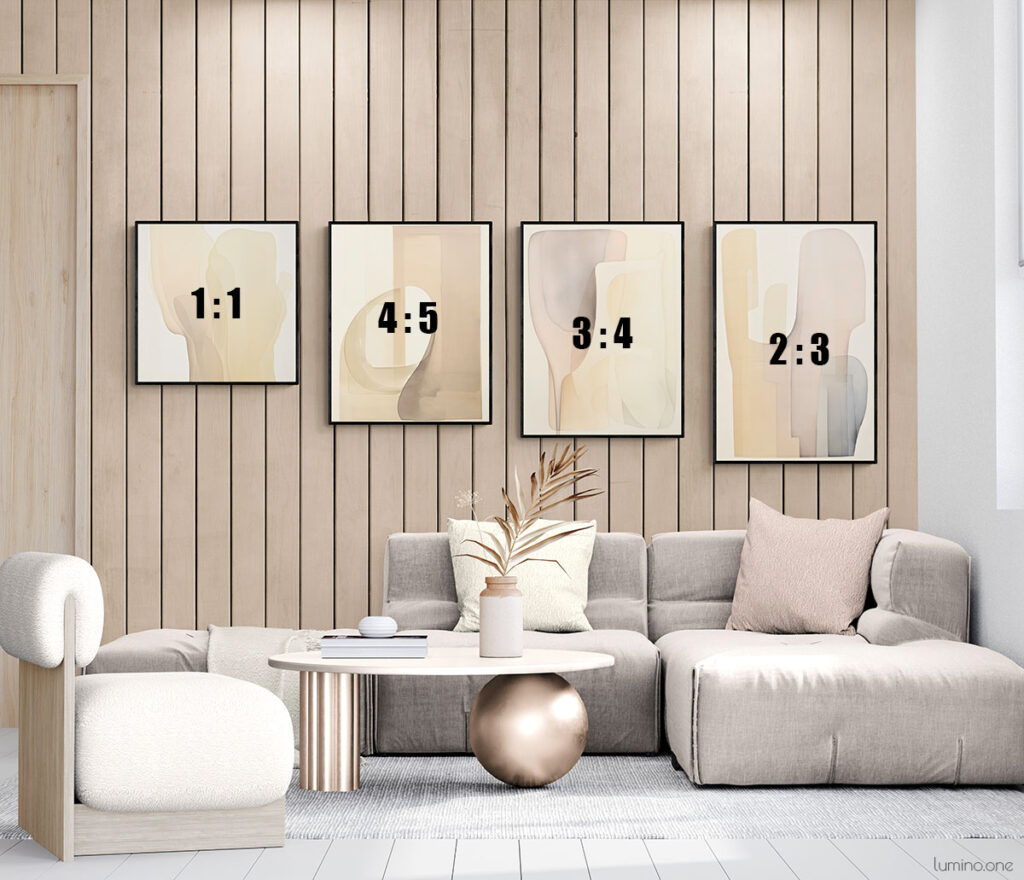
When you’re choosing wall art to adorn your walls, one of the first terms you’ll encounter is ‘aspect ratio’. But what exactly does this mean? Simply put, the aspect ratio is the relationship between the width and height of an image. It’s like the blueprint of your artwork’s shape and proportions. For instance, if an image has an aspect ratio of 2:3, it means the width is two-thirds of the height.
Understanding aspect ratios is key to ensuring that your chosen artwork fits perfectly into your home, maintaining its intended aesthetic without any distortion. Here’s how different aspect ratios can impact the look and feel of your space:
- 1:1 Aspect Ratio: This ratio, representing equal width and height, is excellent for creating a focal point or a symmetrical look. Ideal for spaces where you want the art to stand out without dominating, such as in a study or a cozy nook.
- 2:3 Aspect Ratio: Best suited for larger walls, such as in living rooms or spacious areas. Art prints with this ratio, like 24 x 36 inches, bring harmony and proportion to bigger spaces.
- 3:4 Aspect Ratio: Works well for medium-sized spaces. Prints with this ratio, like 30 x 40 inches, offer a balanced look suitable for bedrooms or dining areas.
- 4:5 Aspect Ratio: Perfect for smaller or narrower walls. Sizes like 16 x 20 inches are great for creating a cozy and intimate atmosphere, ideal for galleries or hallways.
To help you visualize and plan better, here’s a table listing some of the most common art print sizes along with their corresponding aspect ratios:
| Art Print Size (inches) | Aspect Ratio |
|---|---|
| 8″ x 8″ | 1:1 |
| 12″ x 12″ | 1:1 |
| 24″ x 24″ | 1:1 |
| 24″ x 36″ | 2:3 |
| 40″ x 60″ | 2:3 |
| 30″ x 40″ | 3:4 |
| 18″ x 24″ | 3:4 |
| 16″ x 20″ | 4:5 |
| 8″ x 10″ | 4:5 |
This table serves as a quick reference guide, but remember, the right aspect ratio for your space depends on the wall size, room aesthetics, and the visual impact you wish to create. By understanding and considering aspect ratios, you’re on your way to choosing art prints that not only look stunning but also complement and enhance the overall ambiance of your home.
Custom Art Print Sizes
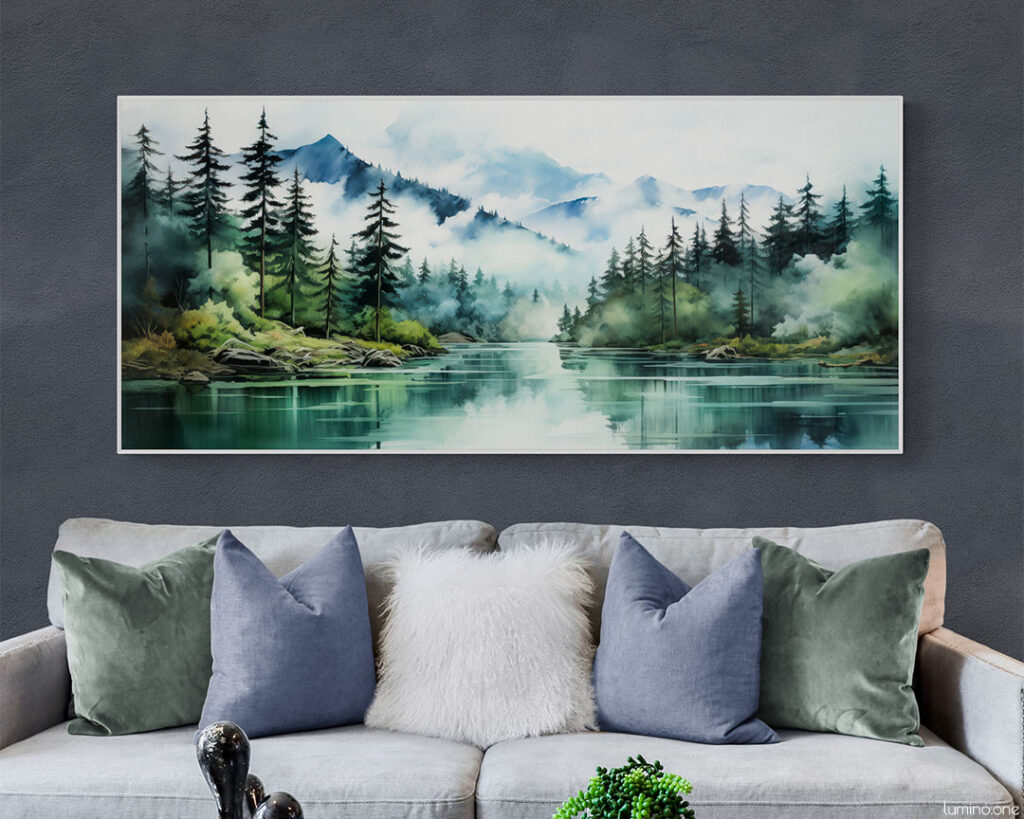
Custom art prints offer a unique opportunity for homeowners to create distinctive and personal wall art. These large art prints can be customized to various popular art print sizes, such as:
- 18” X 14”
- 21” X 16”
- 30” X 22”
- 36” X 26”
- 42” X 30”
This allows homeowners to choose the size that best fits their space requirements.
One should bear in mind, however, that custom prints may carry a higher price tag than standard sizes. Despite this, they still present a budget-friendly option for those seeking custom styling without the significant expenses typically associated with traditional custom artwork.
Selecting the Ideal Art Print Size for Your Space
The critical aspect of interior design lies in selecting the appropriate size of art prints to create aesthetic appeal and balance in your room. A key factor is ensuring that the wall art, particularly when hung above furniture, harmonizes with the surrounding space. Ideally, the artwork should measure between two-thirds and three-fourths of the furniture’s width, effectively occupying about 60% to 75% of the vacant wall space.
For a deeper understanding of these proportions, particularly for artwork above a couch, the blog post “How Big Should Artwork Be Above a Couch? Find the Perfect Proportions” offers valuable guidance. Integrating these rules into your design process can significantly enhance the overall look and feel of a room.
So, how do these sizing guidelines vary depending on the size of the room? The following insights explore this question, helping you make informed decisions to achieve a harmonious and visually appealing interior space.
1. Small Spaces: Bathrooms, Bedrooms, and Offices
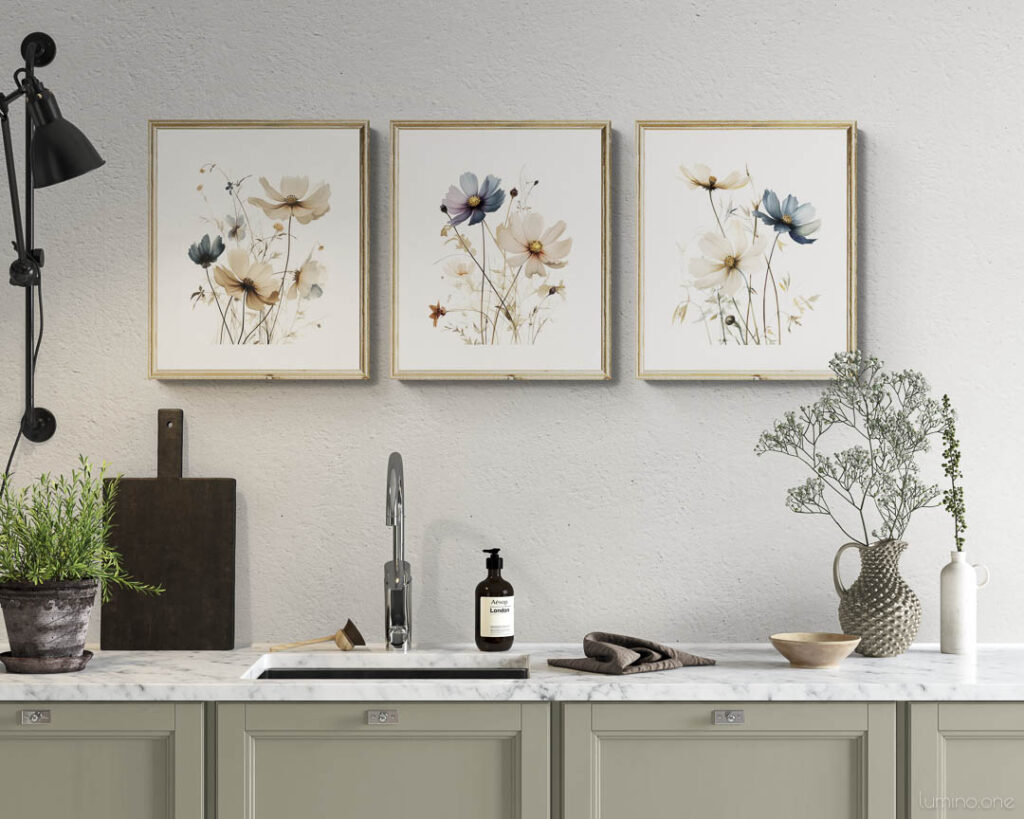
Small spaces like bathrooms, bedrooms, and offices require a careful selection of art print sizes. Small art prints, for instance, 11 x 14 inches, 6 x 8 inches, and 5 x 7 inches, work best in these spaces, balancing the proportion of the space and the artwork.
In areas with limited room, such as on shelves or desks in small offices, smaller prints like art prints sized 5 x 7 inches can be propped up to create a visually appealing display without overwhelming the space.
2. Medium Spaces: Living Rooms and Dining Rooms
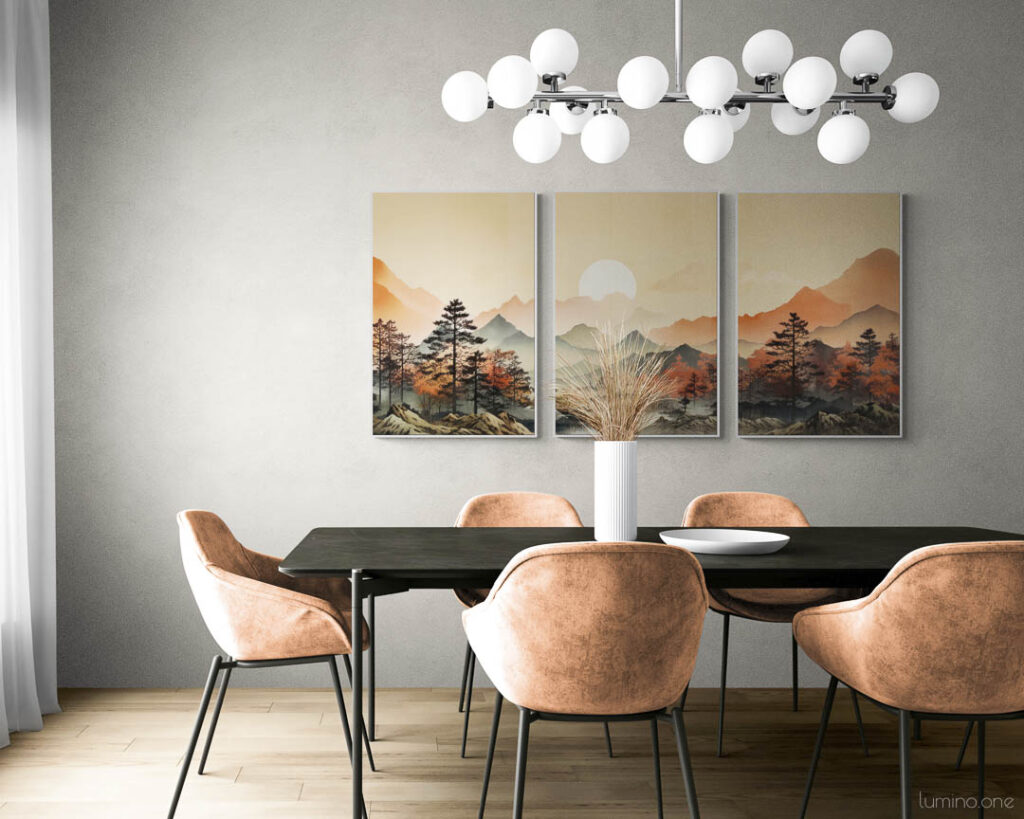
When it comes to medium spaces like living rooms and dining rooms, you have a bit more room to play with. Prints of 18 x 24 inches serve well as intricate focal points within these spaces.
Square art prints of 20 x 20 inches offer an impressive blend of dimensions, fitting for these spacious rooms. If you have a grand living space, you might consider a 28 x 28 inches art print for a substantial aesthetic presence.
3. Large Spaces: Open Floor Plans and High Ceilings
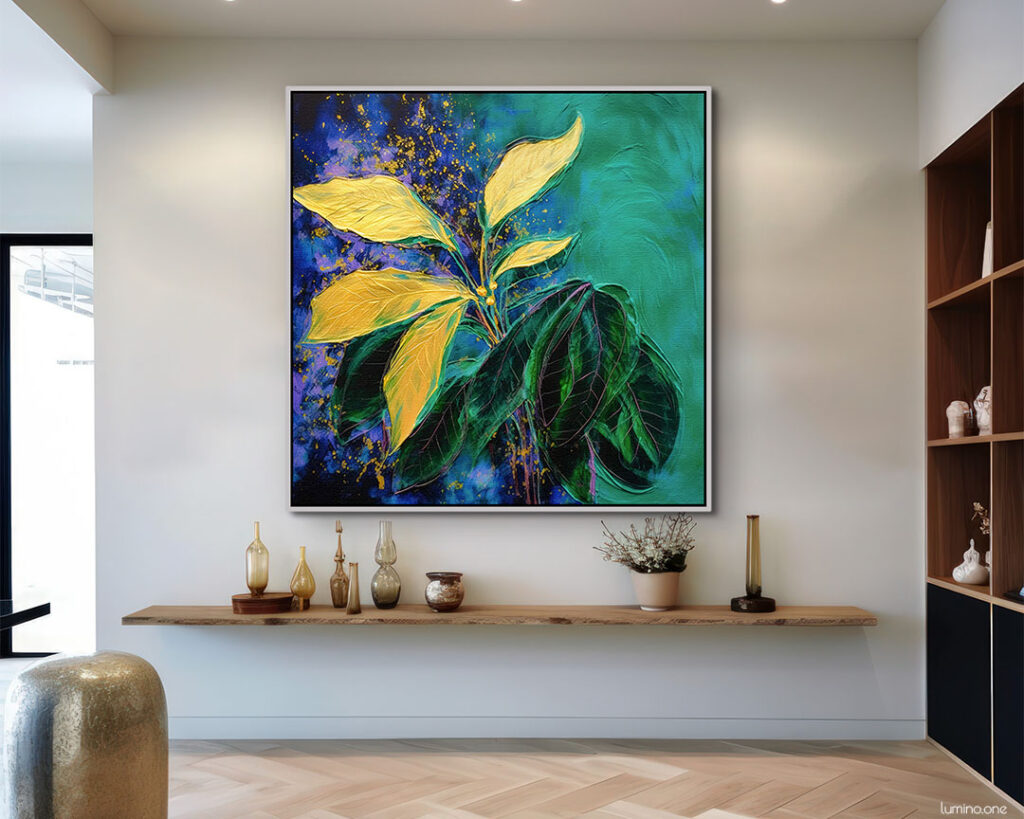
Large spaces with open floor plans and high ceilings offer a unique opportunity to make a bold statement with your art. Some benefits of using oversized wall art in these spaces include:
- Significantly defining the interior design of a space
- Commanding attention and becoming a focal point
- Tying together a room’s color scheme and overall aesthetic
By incorporating oversized wall art, you can create a visually stunning and cohesive look in your space.
For such spaces, choosing art prints of at least 16×20 inches, with 40×54 inches serving as dramatic centerpieces, is recommended. Vertical prints like 36×48 inches are effective for high ceilings, and the decor should occupy 60-75% of the wall space.
Mixing and Matching Art Print Sizes
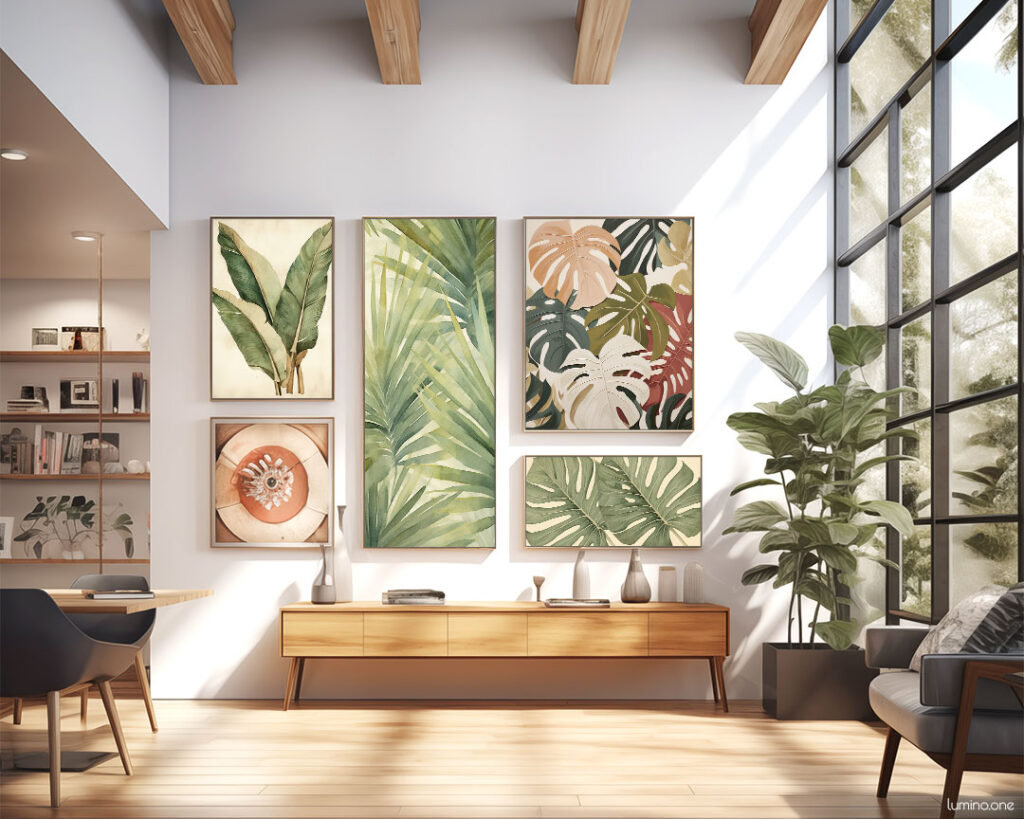
Upon selecting your art prints, including canvas print options, you can mix and match them to create a lively, visually engaging display on your art gallery walls. Gallery walls are a sophisticated and enticing way to mix art print sizes, creating a display that is both dynamic and visually engaging in the art world.
Whether in smaller spaces, where a gallery wall can be particularly striking by incorporating various sizes of prints and frames in different colors, or larger spaces, where a large art print as the centerpiece can anchor the arrangement and draw attention, the mix and match approach adds depth and dimension to your space.
Creating a Cohesive Look
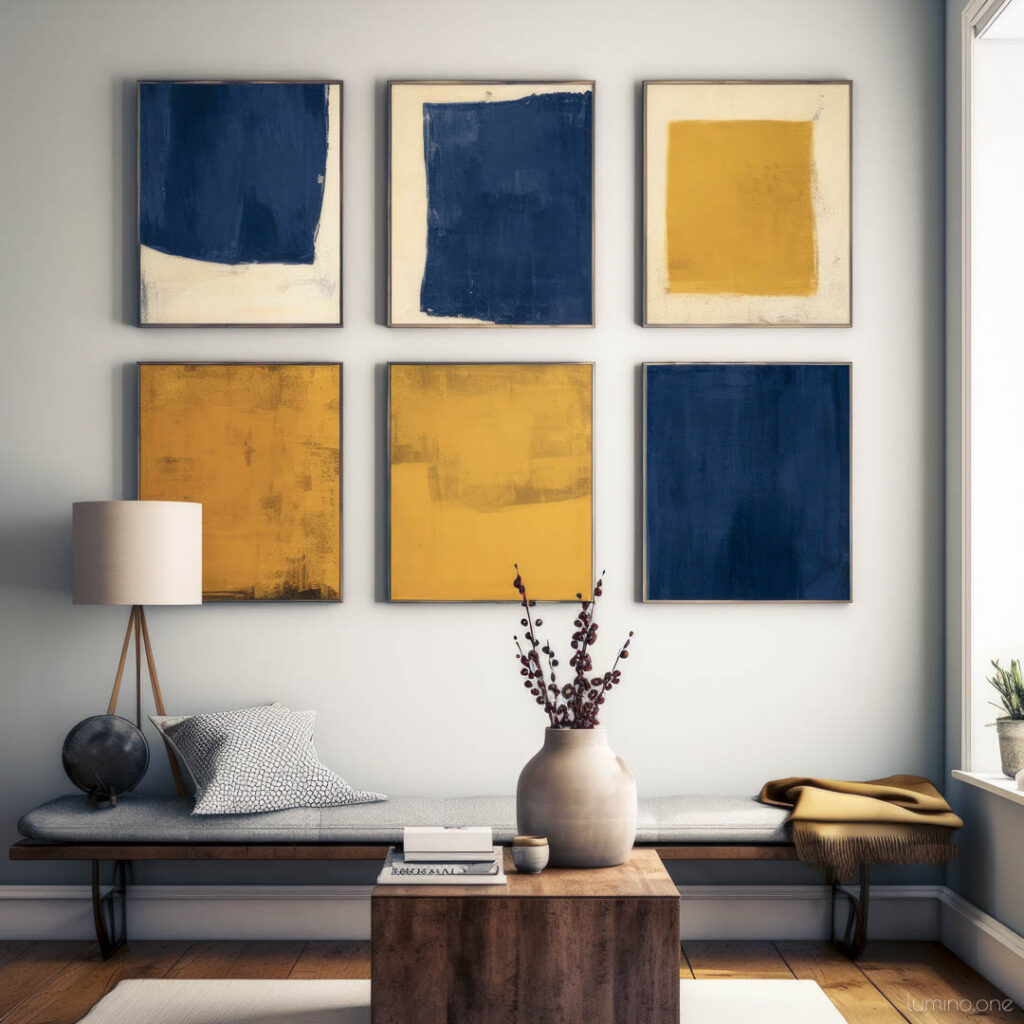
Creating a cohesive look with art prints is like conducting an orchestra – each piece plays a role, but together they create a symphony. This harmony in your home decor isn’t just about matching; it’s about crafting a unified visual story. Let’s explore various ways to achieve this:
- Unified Color Palette: Select a primary color that appears across different prints. This creates a visual thread that ties the room together. For instance, a dash of blue in each print can weave a sense of continuity.
- Analogous Color Scheme: Choose art prints featuring colors adjacent on the color wheel, such as blues, purples, and reds. This approach ensures a smooth and harmonious visual flow, making the space feel thoughtfully curated.
- Common Theme: Opt for prints that share a theme. It could be anything from serene landscapes to dynamic abstracts. This thematic similarity is a subtle yet powerful way to create a sense of unity.
- Consistent Art Medium: Consider the medium of the art. Coordinating prints that are all in watercolor, oil paint, or charcoal, for example, helps in syncing different styles seamlessly. This consistency in medium can subtly tie the room together.
By employing these techniques, you can mix and match different sizes and styles of art prints while still maintaining a cohesive and harmonious aesthetic. The goal is to create a space where each art piece feels like part of a larger, beautifully blended story. Learn more about how to find your unique decorating style here.
Balancing Visual Weight and Scale
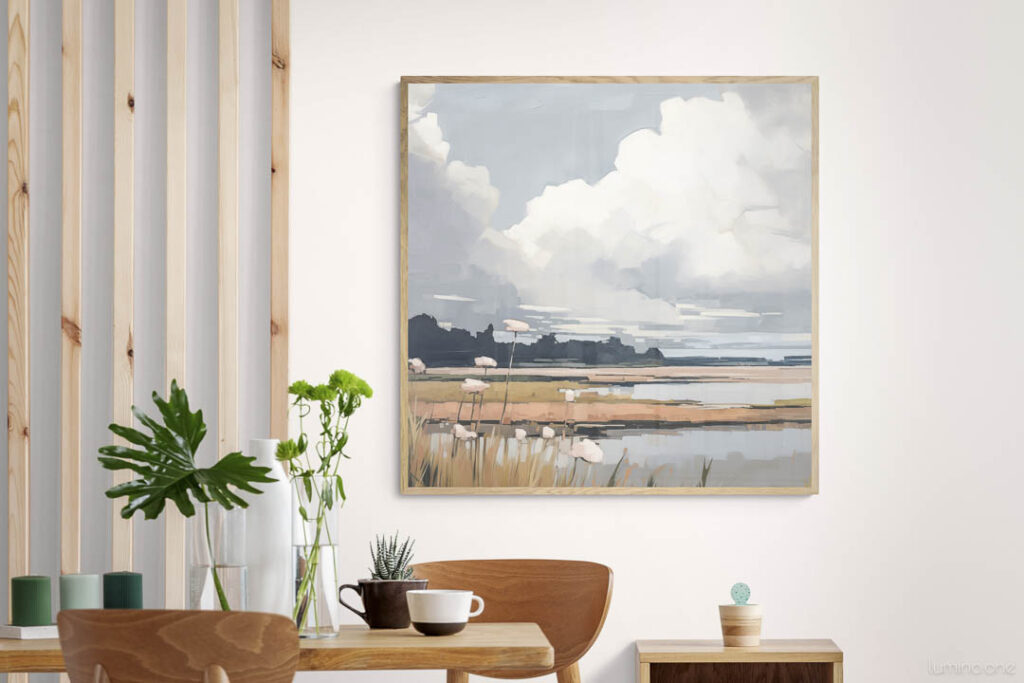
Achieving the perfect balance in your art display is akin to finding the right rhythm in a melody. It’s about creating a visual harmony where each piece complements the other without any single one overpowering the scene. Here are some techniques to balance visual weight and scale:
- Symmetrical Balance: This approach, where each side of the display mirrors the other, creates a look that’s organized and tranquil. It’s perfect for spaces where you want a sense of order and calm.
- Asymmetrical Balance: For a livelier, more dynamic arrangement, consider asymmetrical balance. This involves varying the size and positioning of art prints to create an intentional yet exciting imbalance. It’s ideal for adding a touch of modernity and visual interest to your space.
- Vertical Displays for Narrow Spaces: In tighter areas like hallways, vertical three-panel prints work wonders. They draw the eye upward, enhancing the space without making it feel cramped. For more insights on how art can transform a room, take a look at “Creating Illusions: How Wall Art Can Make a Room Look Bigger”.
- Canvas Prints for Depth: To add depth to a gallery wall, incorporate canvas prints. Their three-dimensional nature makes them naturally stand out, turning them into focal points of your display.
By mixing and matching these techniques, you can create an art display that not only looks visually appealing but also feels just right for your space. It’s about striking that sweet balance where every piece of art feels like it’s exactly where it’s meant to be.
Framing and Displaying Your Art Prints
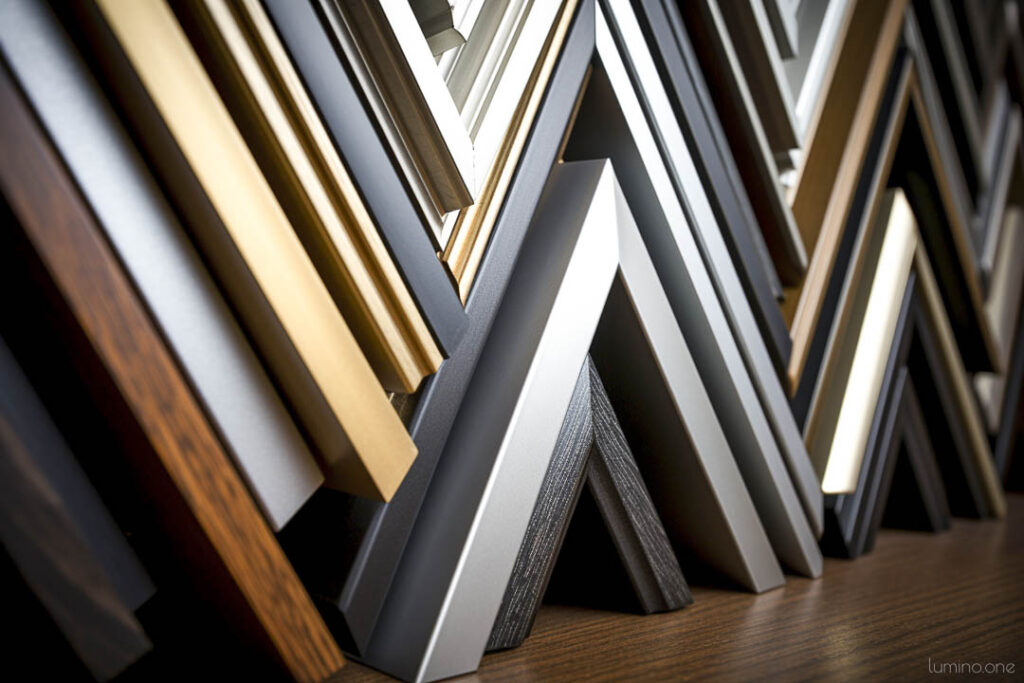
With your art prints selected and placement decided, the subsequent step involves framing and displaying them. This process is an art in itself. The frame not only protects the print but also contributes to the overall aesthetic of the artwork.
The impact of the artwork can be enhanced or diminished by the choice of frame. It’s vital, therefore, to select a frame that complements both the style of the art print and the room’s aesthetic.
Choosing the Right Frame
The choice of a frame should take into account its material and color. Frames can be crafted from materials like wood, metal, and acrylic, each contributing differently to the artwork’s ambiance.
The color of the frame is paramount in complementing the artwork, with options such as classic black, clean white, or natural wood each offering a distinct visual impact. The existing color scheme and decor of the room should guide the frame choice to complement rather than match the surroundings.
Display Techniques for Different Art Print Sizes
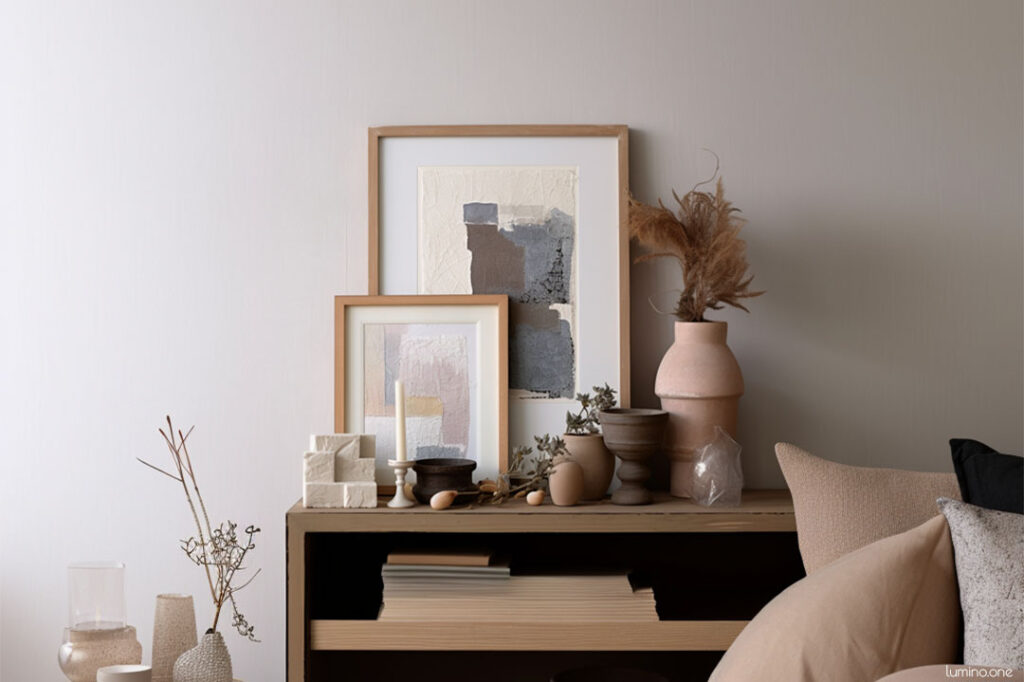
The diversity of display techniques can match that of the art prints themselves. Some techniques to consider include:
- Leaning large prints against walls
- Layering small prints on shelves
- Hanging prints in a gallery wall arrangement
- Using floating frames for a modern look
- Creating a grid pattern with multiple prints
These techniques can add depth and dimension to your display.
Various techniques such as:
- picture shelves
- wood blocks with slots
- display easels
- transforming your digital art into oversized murals
can create dramatic visual impacts without the need for framed galleries. Also, incorporating art prints onto bookshelves among books and small plants can add a dynamic and casual flair to the display.
Summary
To sum up, understanding art print sizes, mixing and matching them, and showcasing them with the right frames and display techniques can transform your space into a visual delight. So, go ahead and explore the world of art prints. Let your walls tell a story that’s uniquely yours.
Read Next: Print Guide for Digital Art: Aspect Ratios, Sizes, Paper
Frequently Asked Questions
What size should my art prints be?
Your art prints should ideally occupy 40% to 60% of your wall space. For a 10-foot wall, a 30 x 40 or 40 x 60 print would be suitable.
What are popular art printable sizes?
Popular art printable sizes include 5×7, 8×10, 11×14, 16×20, 18×24, and 24×36 inches, with a wide selection available at art supply stores. Custom frames are available but standard size frames are often more cost-effective.
What is the most common art print ratio?
The most popular aspect ratio for art printing is 2:3. This ratio is commonly used for poster, canvas, and decal printing, with popular sizes being 24 x 36 inches and 40 x 60 inches.
What Are The Most Common Square Art Print Sizes?
The most common square art print sizes are 8×8, 12×12, 16×16, 20×20, and 24×24 inches.
How do I choose the right size of art print for a room?
Choose an art print that covers 60-75% of the wall space and measures between 2/3 and 3/4 of the furniture’s width when hung above furniture. This ensures the right proportion for the room.
How can I create a cohesive look when mixing and matching different art print sizes?
To create a cohesive look when mixing and matching different art print sizes, consider using a primary color across prints or selecting prints that share a common theme or medium.

